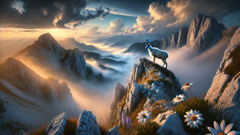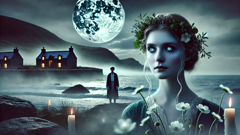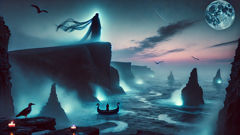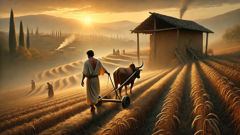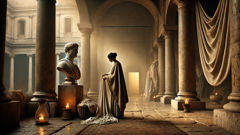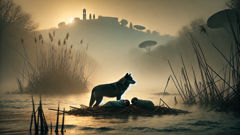Introduction
On the shoulders of Slovenia, where the Julian Alps pierce the sky and cloud shadows carve the slopes, there is a mountain that people name with reverence: Triglav. For generations, shepherds, woodcutters, and travelers have spoken of a guardian that kept the old balance between rock and river, between the hush of forests and the white mouths of glaciers. They called him Zlatorog—Goldenhorn—a white chamois whose horns gleamed like molten sun. The name arrived in village hearths and market stalls in whispers first, then in songs: a chamois that fed from rare alpine flowers, drank from secret spring-water, and, it was said, protected a treasure buried where stone meets sky. This is not simply a story about wealth. It is a tale braided from the taste of cold air at dawn, from the abrasion of wind on bare cliffs, from the sudden hush when a hare freezes and a raven wheels overhead. It is a story of devotion—of the mountain, of an animal, and of the humans who both loved and feared what they could not possess. Keeper of a luminous secret, Zlatorog bound golden myths to the rhythm of seasons. In winter he was a smear against the snow; in spring he moved with the thaw, his golden horns catching first light. To some, he was a sign of blessing; to others, an invitation to greed. In the high meadows beneath the white peaks, the legend began with a shepherd's vow and a flower that would not bow to the foot of mortal desire. This retelling follows the windward paths of Mount Triglav—through ravines and high pastures, across centuries of memory, into the moment when hunger and tenderness met and an age-old pact was tested.
The Mountain's Secret and the Birth of a Legend
The Julian Alps keep time differently. Where valleys collect the stories of villages, the higher slopes remember the slow grammar of rock—how snow compresses into ancient ice, how lichens layer like slow rain, and how wind remembers the voices of those who once walked there. The story of Zlatorog begins in this slow remembering, in a season when the snowline retreated and the slopes grew green with the first fearless grass. People who live in the valley at Trenta and Bohinj tell it as if it were both memory and instruction: listen to the mountain, and do not mistake hunger for right.
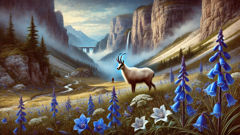
Once, in a village where the roofs smelled of tar and the river sang against stone, there lived a shepherd named Matevž. He was neither the youngest nor the oldest among men who tended flocks on the high pastures, but his hands kept the maps of calluses that come from throwing a sling, hauling a pail, and hauling a body across a frozen meadow. He knew the weather by a crow's angle and the way fog knitted the pine crowns. Matevž had a daughter—Lina—whose laughter was said to open the bellies of storms and make them spill finer rain. Lina grew up with a curious light, the kind that draws moths and mischief both. People noticed the way she watched the slopes; she carried rock dust on her palms like a child that never fully left the earth. She would climb after the chamois and come back with stories of ridgelines where the world felt like glass. For Matevž, the mountain was both provider and teacher. In late spring, when edelweiss crowned the red limestone and the snowmelt swelled the streams, he led his sheep higher, toward a meadow that people called Vrhova trata. There, on a bed of damp humus and blue gentian, Matevž and his flock grazed and slept beneath a sky raw and blunt with stars.
It was on one such evening, when the valley was a pocket of warm air under the bone-cold heights, that Matevž glimpsed Zlatorog. The chamois appeared like a sudden exhale: a white flash that moved across the scree with the assurance of something born to fall but never to break. Its horns were the color of freshly minted gold and curved into a crown that caught moonlight and returned it like promise. The creature fed on rare alpine flowers, the kind that grew where the soil held secrets. Local lore said these flowers—named in hush as the silver-root and snow's-lily—were nourished by waters filtered through caverned veins of ore. The chamois did not move as other animals did; it threaded cliffs as if the rock were woven. Matevž, who had seen much but not everything, felt a tug that was part fear and part reverence. He watched until sunrise, and when he returned to the village he told Lina, and she told a neighbor, and the neighbor told a traveling tinker, and the story spread like a small fire.
The narrative that followed was not just of a brilliant horn and an ethereal coat. It became a ledger of bargains and taboos. The mountain—old as stone and patient as ice—kept a treasure, the villagers said: a stash of jewels, coins, and implements of such workmanship that the words 'wealth' and 'curse' tangled into one another. Zlatorog, the tale said, guarded both the treasure and the means to reach it. Some versions insisted the treasure rested in a stone urn beneath a waterfall; others said it lay in a cavern lit by veins of ore that glowed after midnight. What everyone agreed upon was this: the chamois fed on the blossoms that sprang from the ore-tinged soil. If the chamois drank from the secret spring and fed unmolested, the mountain's bounty remained a blessing—streams flowed, herds fattened, and families ate through winter. But if greed took the teeth of a man and he broke the pact—chasing the chamois, cutting the flowers, plundering the rock—then misfortune would come as swiftly as a stonefall. Songs recorded by village storytellers spoke of hunters and brigands who tried to overcome the guardian. Bells would stop chiming in the village; goats would languish; a fever would pass through barns. The mountain's balance had a price, and Zlatorog's horns were both crown and claim.
So the legend nested itself into the lives of those who lived among the peaks. Women knit its images into garments; men carved it into walking staffs and door lintels. Children learned not to pluck the rare alpine blossom even when its perfume called them like the voice of simple hunger. Travelers arrived with wide eyes and silver coins; some left wiser, others left with pockets full of regret. The mountain remained indifferent in its magnificence, but those who knew the tale felt—beneath laughter and cutting jokes—that the story was an instruction to humility. To take more than the mountain offered was to invite a winter that had no mercy. Over the years this tale accreted detail like lichen on a ledge: names of hunters who challenged Zlatorog, of springs that appeared only at dusk, of a ring of stones that could be read by those who remembered the old prayers. Yet the core never changed: in the high meadows, an animal with golden horns kept what mortal hands could not hold without payment.
As the centuries passed, the legend itself amassed guardians. Priests cautioned the faithful about covetousness in sermons; folk singers tuned the story into melodies that made the hair rise on the back of a listener's neck. When soldiers marched through valleys, elderly women would warn the troops: 'Do not drive your horses into the places where the snow-scented flowers grow. Zlatorog remembers.' To outsiders, the tale seemed to speak only of treasure. To those raised in the shadow of Triglav, it was a moral geography: paths that should not be trod alone and times when silence was the truest prayer. This is how the legend survived: not as a static thing in a book, but as a living seam in the community. It stitched the people to the mountain and taught them to read danger in a skylark's cry. The earliest inscriptions, scratched onto planks and prayer-beads, advise this: Offer thanks for what the land gives; do not force it to give more. Zlatorog, in that climate of reciprocity, became not an object of conquest but a mirror. The golden horns reflected the wants of the heart, and revealed whether a soul sought harmony or a quick-glinted fortune.
Hunters, Heartbreak, and the Mountain's Verdict
The human heart, with its small and urgent hunger, is restless on big mountains. Stories told in taverns and at winter hearths kept the Goldenhorn alive; longing sharpened with each telling, and with longing came those who believed they could either outwit nature or charm it into surrender. Among them were hunters whose names are preserved in the songs as warnings and in some manuscripts as signs of folly. The most repeated of these accounts concerns two men: a huntsman named Jakob and a stranger who came to the valley with eyes like cold steel and a voice that did not fit the valley's timbered houses. Their arrival broke the rhythm of the season like a stone thrown into a quiet pond.
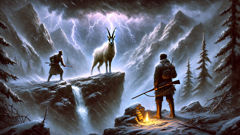
Jakob knew the high pastures as he knew the bend of his own hand. He had tracked chamois since his youth and had a ledger of scars on his hands that could tell of close scrambles and nights spent on wind-blown ledges. The stranger was a merchant from a town across the mountains, and he brought with him instruments polished to glimmer and a hunger that had been fed by the sight of too many gilded things in merchants' stalls. Together, or by dangerous counsel, they decided to seek the treasure they had heard circled in song. Where Matevž's generation had been taught restraint, these two brought a different syllabus: bravery as proof of worth, conquest as proof of right. They climbed in a season when the wind ran like knives and the snow had become thin hard plates on exposed rock. The mountain, as always, demanded respect; it offered none of the easy surrender that greed hopes for.
They found Zlatorog at dusk, as the legends say the chamois sometimes shows itself—on a ledge that girted the sky, drinking from a small, luminous spring. The sight of the animal was almost unbearable to the men who had only thought of its horns as coin rather than crown. Its coat seemed dipped in moonlight; its golden horns shone like small suns. For a heartbeat Jakob remembered the old stories his mother told—about the balance of taking and giving—and his heart pinched with an old loyalty. The stranger, however, had no such memory. He raised his rifle and fired. The shot missed cleanly and made the chamois leap like a white arrow. But as the story goes, Jakob, torn between fear and compulsion, lost his steadiness. He shot again; this time Zlatorog was struck and its blood, dark as peat, stained the pale fur and the stones. The chamois fled up a slope where no man had followed, and at the next ridge it collapsed.
What followed blends grief and wonder. The mountain will not be crossed by cruelty without exacting a toll. It is said that as Zlatorog lay dying, its hooves scraped into the soil and a single cluster of alpine flowers—those rare blooms fed by the mineral veins—broke free and sent a shower of petals into the wind. From its wound a spring welled with an otherworldly light, and the father's hand that once would have known restraint now sought to take. Jakob staggered near the chamois, hearing the strange silence of the slopes, and he saw, at the edge of the animal's sight, the treasure: a cavern mouth where veins of ore glowed faintly, and within, glitter as if the stars had fallen. He could have walked away—returned to Matevž's village with his shame and lived. But human hunger is a tide; it pulls men beyond the safety of their moral shoals.
Jakob reached for a coin, and that moment the mountain answered. A stone fall thundered across the distant ravine; the sky blackened with a sudden squall. The spring that had shone like lamp-water dulled to ordinary, and the glow in the cavern sputtered. The stranger, who had been bold without wisdom, lost his footing on the wet scree and tumbled into a ravine. Jakob, horrified and alone, felt the weight of what had been done. He cradled Zlatorog's head and listened to the animal's last breath like a small bell. There, in that place, something changed. Where the chamois had bled, the flowers withered, and the path that led to the glowing cavern filled with shifting stone and the eerie hush of something closed for good. Villagers who came later said the mountain had withdrawn its treasure and altered its face to hide it. Hunters died in storms that arrived without warning; herds that grazed near the newly sealed place failed to thrive.
The moral engine of the story, however, did not stop at retribution. It spun a deeper truth about reciprocity and the cost of breaking a covenant. People in the valley watched the seasons and noticed other signs: springs that once ran clear grew thin; fog held longer in the hollows; the birds that nested on the ridgelines abandoned certain nooks. Lina—who watched the high pastures with the attention of one who loves both beast and blossom—took to lighting candles and offering bread at the edge of the meadows. Her father, Matevž, spoke to whoever would listen about the need to repair what had been broken. Over time, the villagers began small acts of reparation: they allowed fields to lay fallow where the rare flowers had been picked carelessly; they tended the paths with reverence so that no loose stone would fall and uncover what the mountain had hidden. In the telling, Lina's name became a symbol for those who mended and confessed. Some accounts even allow a softer ending: they say a year after the shooting, a white chamois appeared on a ridge, unscarred and luminous, and that the villagers took this as a sign of forgiveness and a lesson that the mountain's mercy could be coaxed back by steady, humble care.
But legends tend to mirror the era that repeats them. When kings and later, town merchants, came with maps and metal tools, new versions of Zlatorog's tale circulated. Scientists and explorers climbed with instruments that measured the mountain's bones; poets wrote of golden horns and human smallness; hunters still went out with rifles and compasses and sometimes returned with nothing but stories of a white flash on a crag. The mountain itself remained the same indifferent communion of stone and cold. Yet the legend influenced law and practice: on certain slopes, shepherding families agreed to sanctify pastures by tradition, reserving them for breeding and leaving rare blooms untouched. Songs taught children to respect the land as part of their inheritance rather than a purse to be emptied. For those who listened carefully, the story of Zlatorog warns that wealth taken from nature without reciprocity turns blessing into bane.
Over time, the chamois and the treasure became both carved myth and living metaphor. Artists painted Zlatorog with golden horns reflected in mountain tarns. Travelers pressed their hands to cool stones and whispered a promise to themselves: if they passed a rare flower, they would not pluck it. Though greed still appears in every generation, the tale had lodged in the valley's collective memory an ethic of restraint. It taught that the mountain's riches—water, pasture, wood, and the rare mineral veins that give the soil its peculiar taste—are not purely things to possess; they are relationships to be maintained. To this day, when hikers ascend the slopes of Mount Triglav and the wind smells of thyme and iron, the story hums in their ears. They stop at clear springs and cup the water with a reverence learned from a legend: Zlatorog watches, and the mountain remembers.
That memory, like a geologic layer, shows the consequences of choices made long ago. It also holds a hope: a closed heart can reopen; a mountain's verdict can be tempered by human humility. The Goldenhorn's gleam, therefore, is not simply a lure of riches, but a mirror that reflects what a community values. When the mirror is faced honestly, people are capable of returning to the old ways of reciprocity—planting rather than plucking, thanking rather than taking—so that the mountain's balance may be restored and life carried forward for another season.
Conclusion
Legends persist because they carry palpable lessons wrapped in image and feeling. The story of Zlatorog—Goldenhorn of Mount Triglav—endures not as an antiquated superstition but as a living parable about reciprocity, restraint, and the delicate transactions between human desire and the generosity of the natural world. In the folds of the Julian Alps, the tale shaped customs and carved a moral geography that taught people when to take and when to stand back. Hunters and merchants, shepherds and singers, all learned through hard seasons that to force the mountain's hand invites loss. Yet the legend also keeps a quiet room for redemption: through small acts of care—letting pastures rest, protecting rare alpine flowers, listening to the weather—the balance can be mended. Modern hikers and storytellers who visit Mount Triglav sometimes pause at a spring and, whether fully believing in the chamois or not, offer a silent vow: to tread lightly, to leave what they find, and to remember that some treasures are not meant to be possessed but to be honored. The golden horns in the story are therefore more than a promise of material wealth; they are a luminous standard that asks each generation to measure itself by its treatment of the wild. As long as people tell the tale, Zlatorog remains a guardian not just of hidden stone and metal, but of the ethic that sustains life on the mountain. Even now, when clouds unroll across limestone and the slope smells of rain, the legacy of Zlatorog hums in the ridgelines like a distant bell—reminding us that respect, like water, can nourish for centuries, while greed parches fast and unforgivingly. Keep the mountain's counsel, listen to the wind, and let the golden horns teach what counting silver cannot: how to live in the world without taking it apart.

